 |
 Fishing Fishing |

|
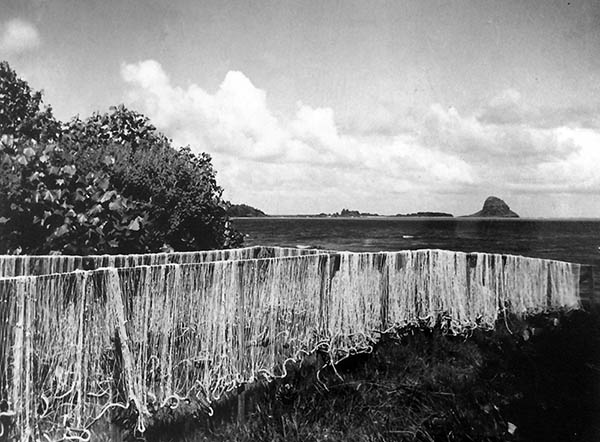
Fishing nets drying at Kualoa. Hawaiʻi State Archives photo, Charles S. Judd collection.
“My father had a fishing boat at Heʻeia Kea pier," Dennis recalls, speaking of the bounty of the waters off He‘eia, "and went bottom fishing and trolling around Kāne‘ohe Bay. We grew up eating moano, uhu, weke,‘ōpakapaka, ‘ula‘ula, uku, kona crab, kahala, ahi, aku, and mahimahi. He also took us crabbing and digging for clams in the shallow shoreline waters of the bay."
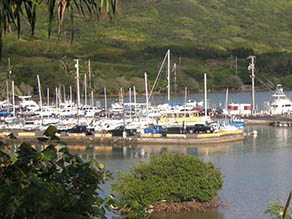
Fishing boats at He‘eia pier.
“Hawaiians were two kinds of fisher people,” Hi‘ilei says. “You’re either a hook-and-line fisher or a net fisher. Nowadays, everybody is sort of honored by ‘Oh, such a good diver!’ But think about it: back in the day, Hawaiians didn’t have masks, they didn’t have goggles. They opened their eyes underwater and that’s what you see. Have you ever tried to open your eyes in salt water? You can’t see much.
“In addition, spearfishing would have been too inefficient. If you’re trying to feed a big ‘ohana or a large community, like spearing one fish at a time would be inefficient. And risky because there’s a lot more sharks from back then than there were now, so you’re either a hook and line fisher or a net fisher. Today in the bay, I kind of grew up net fishing, not so much hook and line, but net fishing is sort of dwindling because it’s kind of an unsustainable practice or viewed that way. People are abusing the net fishing practices, so that’s fine. But people still continue to hook and line, and go diving."
Hiilei elaborates on the various types of fishing:
Hook and Line:
“Summer is an opportunistic time, where we get predators like papio, white papio, that school in the bay, as well as another species called awa‘aua or awaawa, it’s called ten-pounder or a lady fish. They’re both big predators, big carnivores, and they school in the bay. They primarily are schooling because they’re queuing in on the recruitment, juvenile recruitment of baby uhu. That’s their primary food item, what they love to eat.
Awaawa: Milkfish (Chanos chanos). Stages of growth are pua awa (puawa), young; awa ‘aua, medium size; awa, commercial size; awa kalamoho, very large.
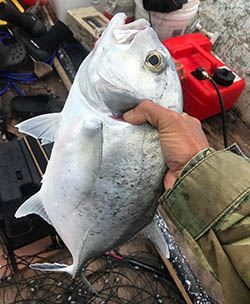
Papio caught with hook and line. Photo by Hi‘ilei Kawelo.
“Now, this is the time of year where we’ll also go trolling in the channels in the bay with a heavy line. We use a heavy line so that we can get our bait down to about 30 feet where they’re schooling. What we’re really looking for is non-stop biting. That’s what we mean by opportunistic, is non-stop biting. Last weekend, we hooked 17 white papio, but sometimes you can fill up a cooler. It’s been a while though since we had a day like that.
"The white papio we’ll catch, and we’ll pretty much just dole them out to family and friends. The awa‘aua we’ll keep on ice for two or three days and then we scrape it to make lomi. The lomi can be frozen, so we’ll just freeze them in quart bags and it’s like the perfect thing to bust out for parties, or if you want to make a pot of fishcake soup.
“Other things during the spring is like akule season. Akule is a scad. They form big schools, too. Now, it’s halalū season. Halalū are the juveniles of the akule, about six inches long. You’ll see a lot of people hooking halalū with a small pole. They hook them like that, take them home and fry them. They’re small, but they’re good eating. ‘Oama is another pasttime in the area. They’re juvenile goatfish, four, five inches. People hook them.
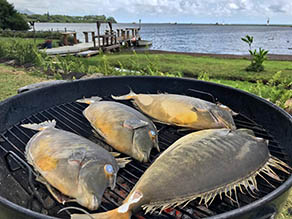
Kala on the grill. Photo by Hi‘ilei Kawelo.
“During August-September is when those ‘oama come in, the juvenile recruits. And you’ll see tons of people, they look like they’re in little huddles, little circles lining the shorelines. That’s what they’re fishing for, with a pole and a small hook. They’re so good eating. You just scale them—don’t need to gut them—and just deep-fry them.”
“Juveniles of a certain species of goatfish, we call it a white weke. The juveniles recruit typically August-September time, but there was a funny influx just a couple weeks ago. So there’s some around, but not in large abundances.
“There’s certain things that we enjoy, like kala. Kala on the barbecue for a family function, everybody loves that. There’s a lot of fish, small reef fish, which we’re accustomed to eating for family parties. One fish called kole is a delicacy. Everybody loves kole. And there’s ‘ō‘io. That’s not something my family really fished for. I only started fishing for it nowadays because I see them off of the fishpond wall.”
Trap Fishing:
“My dad actually did a lot of trap fishing when I was growing up," Hi‘ilei continues, "and throughout college. He stopped, because it’s kind of hard work. You have to be able to get out there at least twice a week to check the traps. He had these big metal traps out of just chicken wire with zinc plates on them so that the trap wouldn’t corrode in the salt water. Sometimes you reinforce it with rebar. and then he would bait the trap. There’s this one big funnel leading into the trap with the bait basket. The bait basket, he only baited it with bread; never fish guts, fish head, and he would put it out and two days later, about two to three days later, he would go and check the trap.
“And he would set his traps off the edge of the reefs. So you’re talking like 25-40 feet depth. So he would have to check it with his scuba gear. He would have a few traps at different places, and there were certain fish that he would catch in the trap. A lot of surgeonfish, some goatfish, but mostly surgeons.
“They’re baited with bread, go check um twice a week, have all kinds of fish in them and take whatever is big enough to eat or whatever is desirable. Otherwise whatever you don’t want goes back into the ocean. Back in the day, maybe there weren’t big fish traps, but there definitely were small ones, hīna‘i.”
Net fishing:
“Moemoe net is lay net. Moe means to make go sleep. That’s when you get your net and you leave it in the ocean. Typically, you set it at dusk, you pick it up in the morning. You just drop it. There’s floats on the top, there’s a lead line on the bottom. In essence, the lead will sit on the bottom of the ocean, floats will keep it suspended, or just keep the net off of the lead, you know. Sometimes, the floats would be on the surface of the water, sometimes they will be subsurface. Basically, you are creating a fence underwater that the fish can’t see. It’s a gill net made from monofilament. Traditionally, back in the day it was ‘olonā, and then it was replaced by nylon, and then there’s monofilament: plastic, the world revolves around plastic.
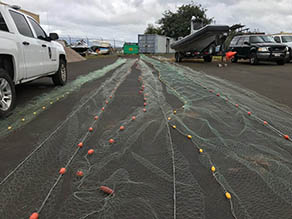
Lay nets. Photo by Hawai‘i Dept. of Land and Natural Resources.
"Typically you stretch it out, and then there’s a pocket on the other end. You have to know which way you are going to make your pocket depending on which way the fish are going to run. They’ll hit the net. Some fish, certain species will just gill themselves.
"Other species are smart. They’ll nose their way along the net, all the way till they hit the pockets, and then they’ll be disoriented and eventually gill themselves. So that’s the job of the pocket. It’s like a spiral. The net can be long, it can be one piece of net, which is typically 125 ft, or it can be multiple pieces of net joined together.
“Akule is a seasonal species that comes into the bay during pretty much from March to May so we’ll lay net for akule. We lay-net also for mullet, ‘ama‘ama, and ‘anae, which is our keystone species of the fishpond.
“The other way is to surround. When you surround, it’s a different practice altogether because basically you see a school of fish, and you got a boat, and a bunch of people, or maybe you’re on shore, but you’re basically surrounding that school of fish that you see. It’s very active management. You surround the school of fish, and once you surround it, you slap the water. They call it pa‘ipa‘i. Pa‘ipa‘i means to hit. The fish get startled and they gill themselves.
“You can also do the same kind of surround fishing with a bag. You can attach a bag to it. Normally, the eye of the net will be smaller. You chase the fish that you surrounded into the bag. You close the bag, and the bag gets sent up and you scoop the fish out. My dad used to do both of those last two types of net fishing in the 70s and 80s, commercially. Making extra money, putting food on the table.
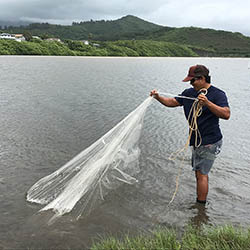
Pulling in a throw net. Photo by Hi‘ilei Kawelo.
“Then there’s throw net, ‘upena ho‘olei is what they call it. ‘Upena means net, and ho‘olei means to create a lei and throwing a cast net. There’s this myth that throwing net is a Hawaiian practice. It is not. It was introduced to Hawai‘i during the Plantation era, but adopted. A lot of things that are really effective were adopted by our people. You see a school of fish, you’re going to throw a net on it and catch whatever. And typically, the fish are gilled.
“Hukilau is something my dad folks used to do. I have not done, but they do it once a year in Kahana. Some of our friends participate in that. It’s become a community educational thing, not so much, ‘Oh my gosh, we’re going to catch so much fish and everybody’s going to go home with fish.’ It’s really just the effect of teaching the kids how to do it. But that’s basically from the shoreline: you take the net out and you lay it in kind of a semicircular fashion, and then attached to the ends of each net is kind of like a rope that you can huki—pull.
“Attached to the rope, there are actual leaves—lau—tī leaves that are tied and hung, dried tī leaves, and then the net gets pulled in slowly. And of course, you can't do this on a rocky bottom; it needs to be sand. Pull it in slowly, slowly, slowly. It definitely takes a community to help with that practice, but the idea is that the lau—the leaves dangling down from the rope—kind of waver and scare the fish into the net. And those fish are gilled; you can have them be gilled, or you can actually have a net with a bag on it, and have the fish go into the bag one.”
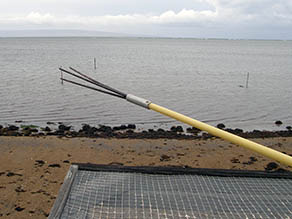
The end of a three-pronged fishing spear.
Spear Fishing:
“We’ll also spear fish, small reef fish or whatever. As we go to look for octopus, if we want to eat certain kind of fish, then we’ll just spear whatever we want to eat. When we go diving out by the breakers, it’s usually because of family parties. So we’ll dive for a lū‘au. We’ll dive out by the breakers to catch small reef fish for family parties. Frying fish is like a big thing here, like a fish fry.
“My brother-in-law dives out by the barrier reef. I used to, but my favorite is everything within the barrier reef. I love shallow water. but there’s everything you need in the bay. There’s no real need to go outside of the breakers, but my brother-in-law dives for those kinds of things. He’ll get us kūmū and uhu and those types of fish, but we like the smaller fish.”
“If you’re truly from a place and your place dictates your practice,” Hi‘ilei concludes, “then as a fisher person you are like a predator. You’re like a predatory fish. You become opportunistic. So that’s how I described being a fisher person—a fisher woman—is you’re opportunistic. It’s whatever is in season, whatever the weather allows for, that’s what you’re going to do.
"So you very much have to mold yourself to the environment. As opposed to someone that only fishes for this thing and only fishes for this thing in this way year-round. Sometimes the resource doesn’t allow for that, and so it’s inappropriate to be doing that during that time of the year, using that type of gear. Whereas if your practice is diversified—like diversified agriculture—it’s just a better practice.”
|
 |

















